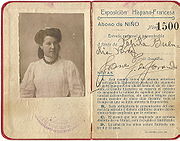
Hispano-French Exposition of 1908
Encyclopedia

Zaragoza
Zaragoza , also called Saragossa in English, is the capital city of the Zaragoza Province and of the autonomous community of Aragon, Spain...
from May to December 1908 to commemorate the hundred-year anniversary of the first siege of Zaragoza
Siege of Saragossa (1808)
The First Siege of Saragossa was a bloody struggle in the Peninsular War. A French army under General Jean-Antoine Verdier besieged, repeatedly stormed, and was repulsed from the Spanish city of Saragossa over the summer of 1808....
.
In 1902, the city of Zaragoza decided to celebrate the first centennial of the siege, and to make the celebration a regular event. The Commemorative Committee of the Siege (Junta Conmemorativa de los Sitios) was formed. An industrial exposition was planned, but its magnitude was uncertain due to the lack of funds.
In 1906, the national government decided to provide 2.5 million pesetas
Spanish peseta
The peseta was the currency of Spain between 1869 and 2002. Along with the French franc, it was also a de facto currency used in Andorra .- Etymology :...
to finance the exposition, whereupon the executive committee of the Exposition was established, headed by Basilio Paraíso
Basilio Paraíso
Basilio Paraíso was an Aragonese businessman and politician.The son of a teacher, he studied in Huesca and Zaragoza, where he obtained a degree in medicine and began his career as a businessman....
, a local businessman. Paraiso organized the commemoration of the centenary and the Exposition, placing Ricardo Magdalena in charge of the planning. The exposition was regarded as a modern event, with the purpose of demonstrating the cultural and economic vitality of the city and of Aragon
Aragon
Aragon is a modern autonomous community in Spain, coextensive with the medieval Kingdom of Aragon. Located in northeastern Spain, the Aragonese autonomous community comprises three provinces : Huesca, Zaragoza, and Teruel. Its capital is Zaragoza...
, while at the same time serving to strengthen Spanish ties with their French neighbours, and heal wounds resulting from the events of the Napoleonic Wars
Napoleonic Wars
The Napoleonic Wars were a series of wars declared against Napoleon's French Empire by opposing coalitions that ran from 1803 to 1815. As a continuation of the wars sparked by the French Revolution of 1789, they revolutionised European armies and played out on an unprecedented scale, mainly due to...
of the previous century.
Even so, not everything was done entirely according to Paraiso's taste. Conservative elements such as Florencio Jardiel, the president of the organizational committee of the centenary, also had their say in the organization and in the execution of the event. Jardiel's mark could be seen in the importance of the Marine Pavilion and in the results of the National Pedagogical Congress of Zaragoza.

Neo-Renaissance
Renaissance Revival is an all-encompassing designation that covers many 19th century architectural revival styles which were neither Grecian nor Gothic but which instead drew inspiration from a wide range of classicizing Italian modes...
palace inspired by the Aragonese palaces of the 16th century, and the Gran Casino, a modernist
Modern architecture
Modern architecture is generally characterized by simplification of form and creation of ornament from the structure and theme of the building. It is a term applied to an overarching movement, with its exact definition and scope varying widely...
building that existed until 1930. The younger architects were in charge of the other buildings. Félix Navarro was responsible for the Escuela de Artes y Oficios which is still standing, in the Plaza de los Sitios. In the center of the Plaza was erected the Monumento a los Sitios by Agustí Querol Subirats
Agustí Querol Subirats
Agustí Querol i Subirats was a prominent Spanish sculptor, born in Tortosa, Catalonia. - Life :...
, a Catalonian sculptor who executed it in a modernist style; it still can be seen today.
The majority of the buildings were modernist and of a temporary nature, constructed with inexpensive materials such as wood, plaster and adobe
Adobe
Adobe is a natural building material made from sand, clay, water, and some kind of fibrous or organic material , which the builders shape into bricks using frames and dry in the sun. Adobe buildings are similar to cob and mudbrick buildings. Adobe structures are extremely durable, and account for...
, and torn down after the Exposition. Among those razed were the Theater, the Entrance Gate, the Food Pavilion, the Marian Pavilion, and the Central Pavilion, or French Pavilion, in a neo-Rococo style, which thrilled the visitors with a section dedicated to the French automobile industry.
.jpg)
Altos Hornos de Vizcaya
Altos Hornos de Vizcaya was a ironworks business that began in 1902 in Bilbao with the merger of three iron and steel businesses: Altos Hornos de Bilbao, La Vizcaya, and La Iberia...
, which had its own pavilion. Catalonia also had a significant presence (there was a small incident during a toast to the regional architect Josep Puig i Cadafalch
Josep Puig i Cadafalch
Josep Puig i Cadafalch was a Spanish Catalan Modernista architect who designed many significant buildings in Barcelona...
that did not please some conservative Zaragozans).

The public success, with more than half a million visitors, caused the event to be extended by two months. Among the notable visitors was King Alfonso XIII
Alfonso XIII of Spain
Alfonso XIII was King of Spain from 1886 until 1931. His mother, Maria Christina of Austria, was appointed regent during his minority...
, who visited the Exposition on several occasions.
Zaragoza hosted another Exposition, Expo 2008
Expo 2008
Expo 2008 was an international exposition held from Saturday, 14 June to Sunday, 14 September 2008 in Zaragoza, Spain, with the theme of "Water and Sustainable Development". The exposition was placed in a meander of the river Ebro...
, which coincided with the bicentenary of the siege, with the intent of turning this into a centennial event.

